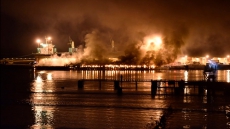OTTAWA — The first hint Pte. Alfred Baggs had that something was wrong came when a horse-drawn French ammunition wagon rattled past his startled foot patrol late in the afternoon amid the chalky, ruined streets of Vlamertinghe, a Belgian town.
Headed in the wrong direction, it was followed quickly by a car, driven by a French colonel and overflowing with wounded who "looked deathly pale," Baggs confided to his brown, leather-bound field notebook.
The enemy had broken through, he was told, before the car and the caissons disappeared in a cloud of dust towards the crushed Belgian city of Ypres, just a few kilometres distant.
Baggs, a Briton by birth but a new Canadian by choice, seemed shocked and excited by the prospect of action.
It was April 22, 1915, a sunny, but cold, spring day.
The 1st Canadian Division had only been in the field a few weeks when the Germans, who'd regularly shelled the tiny bulge of territory known as the Ypres Salient, opened a massive offensive.
Mostly forgotten in popular imagination and rarely taught in high school history, the Second Battle of Ypres was the baptism of fire for the fledgling force of Canadians, hastily assembled at the outbreak of the First World War the previous summer.
At the time, Ypres was the last major Belgian city not under the boot of Kaiser Wihelm's army, and had been the scene of a desperate, successful stand by the British Expeditionary Force the previous fall.
It is also notable as the first time the Germans unleashed clouds of poison gas to subdue resistance in allied trenches, says Melanie Morin-Pelletier, the Canadian War Museum's expert in the First World War.
The Canadians would be mostly spared the initial, horrifying waves of green vapour which drifted across no man's land. It was pushed on by the wind after being released from 5,730 industrial canisters on the German lines.
The initial blow fell mostly on the French colonial troops who had rushed past Baggs. He noted in his diary how everyone was talking about how the enemy attack that had taken place under the cover of "asphyxiation gas."
At the time, none of the Allied commanders knew precisely what type of gas had been used, although they had been warned it was coming by captured German prisoners, according to the army's official history.
But Morin-Pelletier said there was little they could do to prepare for it.
It was a Canadian doctor — Capt. Francis Scrimger — who first recognized the eerie, floating cloud as chlorine.
Gas masks were just in their infancy and the best protection Scrimger could suggest was for troops to urinate into their handkerchiefs and hold them over their faces until the cloud had passed.
As they fought to close a six-kilometre gap in the line created by the French collapse, the Canadians would feel the full force of gas on April 24, two days after the first volley.
Capt. William Boyd, a medical officer attached to a field ambulance unit, visited a casualty clearing station jammed with the dead and the dying.
"There I saw a sight which for sheer ghastliness equals anything to be seen in any dressing station," he wrote in memoirs published in 1916.
"Some were lying in a state of stupor, the flies buzzing about their faces; some were sitting up gasping for breath, with hands and faces of a deep, dusky hue, evidently in the greatest distress; over the countenance of others the pallid hues of death were beginning to creep, whilst a few had fallen back and with gurglings in the throat were passing away into the undiscovered country."
The Canadians drove the Germans back over several days, but at great cost.
In a series of counterattacks that bought time for the British and French to deploy reinforcements, the 1st Canadian Division and the Princess Patricia's Canadian Light Infantry, which fought separately, lost 6,714 dead and wounded, or about one man in three.
Both the official Canadian army history, written after the war, and Baggs' diary paint a picture of desperate, confused skirmishes. They were mostly fought in the darkness amid the sudden, unworldly flash of shells and the spark of rifle fire.
Told to fix bayonets, Baggs followed his chum into the hedge with the Germans on the other side. They lost sight of one another.
"Poor old Ned (Lawson) has never been heard of since so we can only pray that he met his death facing the enemy," Baggs wrote later.
Boyd's account of the counterattacks spoke about medics who arrived on the scene and "found no field ambulance, no doctors, nothing but men fighting in dark, ploughed field; the grim scene lit by the light of star-shells, with shrapnel bursting all along the road to prevent reinforcements coming up."
Under fire and with two of their number killed, the medics "had to pick the wounded out of the fields and ditches, and get them into the cars as best they could."
Boyd went on to be a noted pathologist and founding member of the National Cancer Institute.
Baggs also survived the war, but never returned to Canada.
He was wounded and suffered shell shock in 1916, but remained in uniform as a military police officer until the end of the war when he was discharged and chose to marry his English sweetheart.




